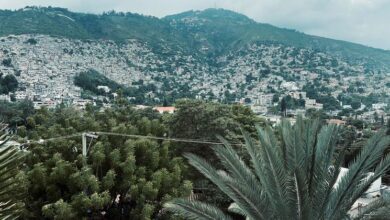Climate change: ‘Glacier graveyard’ exposes existential threat of melting ice

Along with the majestic and iconic monument to the devastation of unchecked climate change, the ceremony on August 17 also saw the unveiling of the Global Glacier Casualty list of 15 extinct and endangered glaciers by Rice University in Texas – the impetus behind the entire project.
According to scientists, global warming has led to the disappearance of thousands of glaciers around the world since 2000. It is predicted that at least half of these glaciers will disappear by 2100.
Researchers from Rice University in Houston, the Icelandic Meteorological Office, geologists, glaciologists and government leaders attended the ceremony ahead of what was to come. International Year of Glacier Conservationby 2025.
UNESCOUnited Nations Educational, Scientific and Cultural Organization and the United Nations weather agency World Meteorological Organizationis one of several event co-organizers in Iceland.
Tombstone, a ‘profound reminder’
The glacier cemetery includes 15 tombstones carved from ice by Icelandic ice sculptor Ottó Magnússon.
“We have never needed a graveyard for glaciers before,” said Cymene Howe of Rice University. “Now we do. And while these gravestones will melt—like the frozen gravestones—we hope the ceremony and the frozen gravestones will serve as a poignant reminder that the world’s glaciers will suffer the same fate if swift action is not taken.”
The gravestones are located in a field by the sea on the Seltjarnarnes peninsula, bordering Reykjavík, with stunning views of the Snæfellsjökull glacier across Faxaflói Bay.
The Snæfellsjökull glacier is well known to students of world literature as the place of entry and disembarkation of the main characters in Jules Verne’s classic science fiction novel, Journey to the Center of the Earth.
Although the Snæfellsjökull glacier has lost more than half its area since the late 19th century, there are many glaciers that are in worse condition.
Among the most severely damaged places listed as “lost” are the Pizol Glacier, Switzerland (2019), the Sarenne Glacier, France (2023), the Anderson Glacier, United States (2015), and the Martial Sur Glacier, Argentina (2018).
More information to come
Five years ago, the premature death of Iceland’s Ok glacier was commemorated in a ceremony attended by then-Icelandic Prime Minister Katrín Jakobsdóttir and former Irish President Mary Robinson.
“Because that glacier has a plaque and a reputation, we chose another Icelandic glacier to be included in the first list,” said one of the organizers, glaciologist Hrafnhildur Hannesdóttir at the Icelandic Meteorological Office. United Nations Regional Information Centre for Western Europe (UNRIC).
“It is likely that many others will follow suit, as there is no indication that CO2 is decreasing.”
Iceland has lost 70 of its 400 glaciers. Some of them, like the next candidate for extinction, Hofsjökull East, are actually very small. “It’s relatively low and flat and won’t last very long,” says Hannesdóttir.

Jökulsárlón Ice Lagoon in southeastern Iceland.
Sea levels will rise
According to Icelandic glaciologist Thorsteinn Thorsteinsson, in an interview with UNRIC, if all of Iceland’s glaciers disappeared, the meltwater would raise global sea levels by one centimeter – roughly the same as the combined sea level rise of all the glaciers in the Himalayas.
The glaciers of the Himalayas cover around 40,000 square kilometres. However, Vatnajökull alone, which is Iceland’s – and indeed Europe’s – largest glacier south of the Arctic Circle, covers 7,700 square kilometres.2.
For a variety of reasons, the “big one,” as it is called, is expected to last another three centuries or so.
By contrast, Iceland’s second-largest glacier, Langjökull, is in greater danger, in part because it is much lower. Scientists predict that only 10 to 20 percent of its volume will remain by 2100.
Asian Water Tower
The melting of glaciers in the Himalayas attracts more attention than the fate of glaciers in Iceland, for understandable reasons.
The icy mountains of the Hindu-Kush-Himalaya region are known as the “Water Towers of Asia” because they feed some of the most important rivers on Earth, such as the Indus, Ganges, Brahmaputra, and Yangtze – all of which originate in a relatively small area.
They are considered “a lifeline for hundreds of millions, if not billions of people,” says Mr Thorsteinsson, and have lost 40 per cent of their mass since the late 19th century.
It is predicted that 75 percent will be lost by the end of this century.
“But their melting does not mean that 2-3 billion people in China and India will die of thirst. For example, the Ganges originates from a small glacier, the Gangotri. Rain and snow will continue to fall and groundwater and monsoons will feed all these big rivers,” he told UNRIC.
His colleague Hrafnhildur Hannesdóttir points out that melting has increased the risk of flooding and landslides, with frequent and high death tolls.
“We have to look at the big picture, not just focus on one thing at a time, and we shouldn’t forget that rising sea levels will affect many more people.”

A mountain glacier is shrinking due to rising temperatures and less snowfall in Kargil District, India.
Important to the story of humanity
There’s also an important cultural dimension: “All these glaciers are tied to our lives,” says Dominic Boyer of Rice University.
“They belong to the time we had together, not abstract losses in the future, but real losses that you can feel and will feel with all your senses.”
Indeed, glaciers are also part of Iceland’s identity. The national flag features a red cross with a white border and a blue body.
Of course, the cross symbolizes Christianity, red symbolizes the fire of the volcano, blue symbolizes the sky and sea, and white symbolizes ice and snow.
The positive is that the white may not disappear – even if the glaciers disappear.
The majestic Snæfellsjökull may have lost its status as a glacier, but its white ice may still remain. “In fact, the ice on the mountain is quite thin and grey, which is not very pretty,” Thorsteinsson explains.
“But the snow keeps falling, and this is actually the snow peak we see the furthest and all the photographers love.”
International Year
The United Nations General Assembly has declared 2025 International Year of Glacier Conservation and declared March 21 of each year as World Glacier Day.




